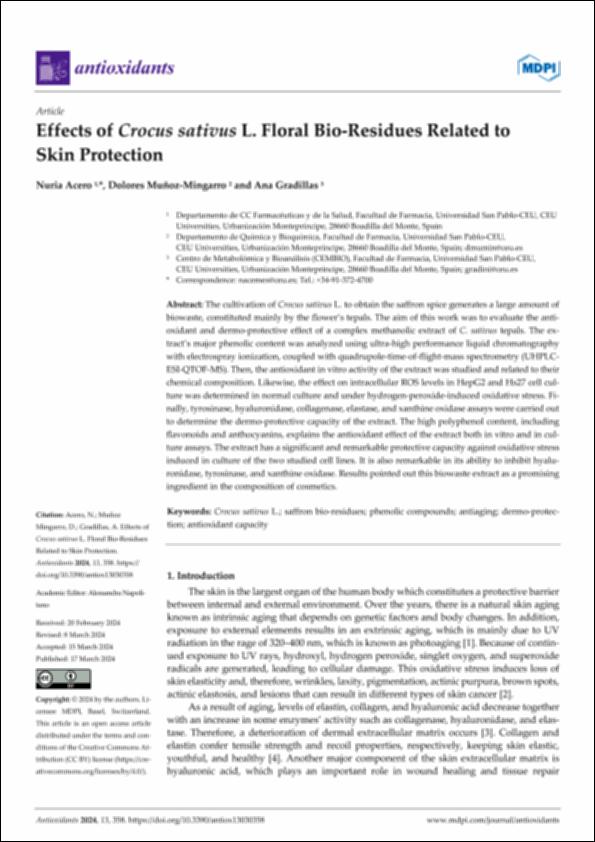Please use this identifier to cite or link to this item:
http://hdl.handle.net/10637/15712Effects of Crocus sativus L. Floral Bio-Residues Related to Skin Protection
| Title: | Effects of Crocus sativus L. Floral Bio-Residues Related to Skin Protection |
| Authors : | Acero de Mesa, Nuria Muñoz Mingarro, Dolores Gradillas Nicolás, Ana |
| Keywords: | Crocus sativus L.; Saffron bio-residues; Phenolic compounds; Antiaging; Dermo-protection; Antioxidant capacity |
| Publisher: | MDPI |
| Citation: | Acero, N.; Muñoz-Mingarro, D.; Gradillas, A. Effects of Crocus sativus L. Floral Bio-Residues Related to Skin Protection. Antioxidants 2024, 13, 358. https://doi.org/10.3390/antiox13030358 |
| Abstract: | The cultivation of Crocus sativus L. to obtain the saffron spice generates a large amount of biowaste, constituted mainly by the flower’s tepals. The aim of this work was to evaluate the antioxidant and dermo-protective effect of a complex methanolic extract of C. sativus tepals. The extract’s major phenolic content was analyzed using ultra-high performance liquid chromatography with electrospray ionization, coupled with quadrupole-time-of-flight-mass spectrometry (UHPLCESI- QTOF-MS). Then, the antioxidant in vitro activity of the extract was studied and related to their chemical composition. Likewise, the effect on intracellular ROS levels in HepG2 and Hs27 cell culture was determined in normal culture and under hydrogen-peroxide-induced oxidative stress. Finally, tyrosinase, hyaluronidase, collagenase, elastase, and xanthine oxidase assays were carried out to determine the dermo-protective capacity of the extract. The high polyphenol content, including flavonoids and anthocyanins, explains the antioxidant effect of the extract both in vitro and in culture assays. The extract has a significant and remarkable protective capacity against oxidative stress induced in culture of the two studied cell lines. It is also remarkable in its ability to inhibit hyaluronidase, tyrosinase, and xanthine oxidase. Results pointed out this biowaste extract as a promising ingredient in the composition of cosmetics. |
| URI: | http://hdl.handle.net/10637/15712 |
| Rights : | http://creativecommons.org/licenses/by-nc-nd/4.0/deed.es OpenAccess |
| ISSN: | 2076-3921 |
| Issue Date: | 17-Mar-2024 |
| Center : | Universidad San Pablo-CEU |
| Appears in Collections: | Facultad de Farmacia |
Items in DSpace are protected by copyright, with all rights reserved, unless otherwise indicated.


